How to Get Rid of Fleas on Puppies
PUPPY

Posted by bravectosouthafrica – 15 July 2019
Guide Overview
- What are fleas on puppies?
- Common puppy parasites to monitor
- How can your pooch get fleas?
- Simple tips to take control of fleas
- Read through our frequently asked questions (FAQs) about Bravecto®
- Get your dose of Bravecto® today!
Bringing a puppy into a new home environment is exciting. Soft skin, puppy breath and cuddles on demand – what more could you want in your house? Now, as thrilling as it is, you need to be patient and remember that your pup finding his paws in a new “world” can take time. And, before you get high hopes up on your healthy parasite-free pup, always keep your house clean and consider the best flea control for puppies to prevent fleas and more. If you notice that your furry friend is starting to scratch, keep reading to learn how to get rid of fleas on puppies.
What are fleas on puppies?
Before we discuss what fleas are, it’s essential to understand the need for a clean pet when trying to prevent these parasites from entering (and possibly infesting) your home.
Yes, your pup’s dirty paws are amongst some of the most adorable things. But a fur ball that is dirty is yet another invitation for fleas to make their way onto your dog’s coat. Fleas are a major concern for pet parents as they are costly to get rid of, and they can lead to severe illnesses for your puppy if dismissed. Originating from Siphonaptera, fleas are wingless insects that consume blood from a host organism. Over time, this parasite group has grown in leaps and bounds.
Fleas feed on species that appeal to them. Of the 2000 flea species in the world, the most common species in South Africa are dog fleas, cat fleas, human fleas and rat fleas.
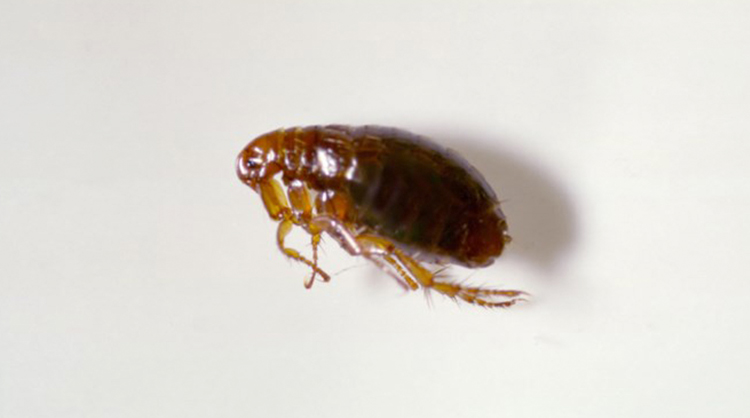
Unless your pooch is scratching, it might be challenging to spot fleas as they are minute in size. But, as this article suggests, “just because you can’t see them, it doesn’t mean they’re not there.” Grooming is not a solution to helping you get rid of fleas on puppies. Once a flea has infested your doggy’s coat, you will notice tiny black specs on your dog’s fur. If you suspect fleas and notice “dirt”, you can put a damp tissue onto your dog’s coat and see if the dirt changes colour. “If it’s flea dirt, the specks will turn red because of the digested blood they contain.” You will be able to notice these spots of dirt on your puppy’s lower body. Fleas on puppies infest behind the shoulders, ears, groin and at the base of the tail, as these are warm areas.
Regardless of whether you find fleas or not, it’s crucial that you consult with a vet about the best flea treatments for puppies. Bravecto® offers a Chew treatment for dogs, as well as a Spot-On solution, each with the same benefits but different coverage options. Bravecto® Chew will protect your pup against fleas for 12-weeks whereas Bravecto® Spot-On For Dogs will provide 6-months of flea protection with just one dose.
Common puppy parasites to monitor
Owning a pet, especially a puppy is a major responsibility. You will be wanting to give your pooch the best possible care, finding ways to socialise them and, of course, researching ways to provide them with a happy and healthy lifestyle. One of these responsibilities includes finding the best flea treatment for puppies and protecting your dog against any other parasite that might make its way into your puppy’s coat. Put simply, a parasite can be described as an organism that lives off something. For example, your puppy. These horrible pests survive by consuming your puppy’s blood, and while a flea roams around on top of your dog’s skin, other parasites can live beneath the skin, inside their intestines and in their bloodstream. Without treatment, these parasites, such as fleas on puppies, can lead to severe illnesses and death.
Here are the most popular parasites that can be found on your puppy:
Fleas
The first step to learning how to get rid of fleas on puppies is knowing how fleas look and what symptoms they cause. If you notice your doggo scratching its tail, ears and stomach, they’re trying to address the irritation. The flea lifecycle can take between two weeks to three months, and during this time, you are likely to be dealing with a major infestation in your home or on your pet.
If swallowed, your puppy is also at risk of contracting a tapeworm. According to this article, “the tapeworm is initially inside the flea, and then grows inside your pet. They are segmented parasites that can be as small as 1.27 cm and look like maggots but can also be as long as 30.48 cm. They can cause an itchy rear end as well as weight loss. But they are easily treated by your veterinarian.” In addition to this condition, the worst-case scenario can lead to anaemia. “This is when young or small animals (such as puppies and kittens) have a severe flea infestation and the fleas feed so much on these animals that their red blood cell count decreases.” The article continues, “this can be a medical emergency and even fatal in some cases if left untreated. Luckily, treatment by a veterinarian in a timely manner is usually able to reverse the effects.”

Ticks
Ticks also thrive in warm climates. These parasites have a lifecycle of three weeks to three years and can transmit a variety of illnesses to your pooch such as biliary. Ideally, you will notice a change in your pet’s behaviour before it gets to this, and common symptoms include diarrhoea, inflammation in joints, loss of energy and appetite. If you want to inspect your pup for ticks, know where to look. Search your dog carefully and frequently to avoid tick bites; otherwise, treat your puppy with a tick and flea treatment for puppies. Bravecto®can be used on puppies from 8-weeks and will protect against fleas for 12-weeks or longer, depending on the Bravecto®product you choose.
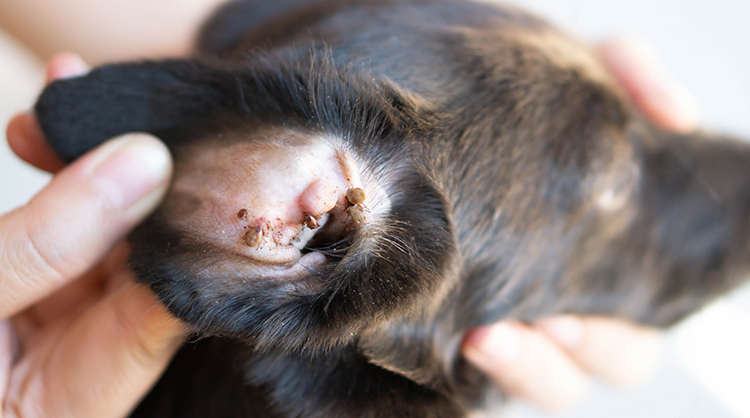
Ear mites
You will be able to pick up that your dog has ear mites when they scratch and shake their head. This is incredibly itchy and often painful for dogs, as it causes an inflammation which may lead to further damage if not caught in time. It’s important that you learn how to spot and treat ear mites to prevent these parasites from infesting your doggo’s soft floppy ears.
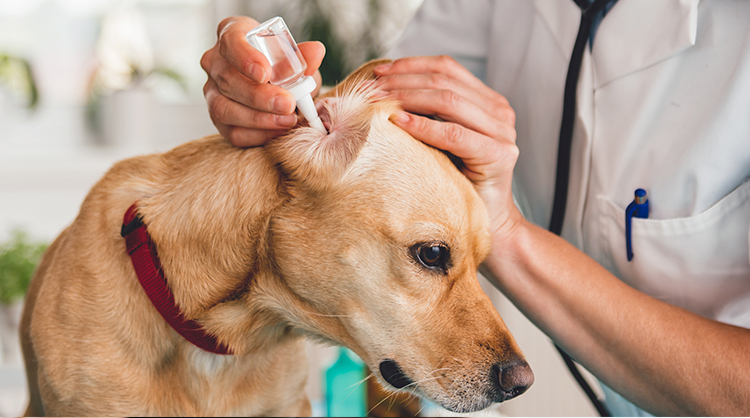
If you want to know how to get rid of fleas on puppies, as well as ticks and ear mites, you need to invest in the best flea treatments for puppies. Bravecto® is a great choice as it can treat all three of these parasites in one dose. We have two products that can assist your pooch, both offering long-term coverage with one being extended coverage. Our Bravecto® Chew offers 12 weeks of continuous protection against ticks, fleas and ear mites. Bravecto® Spot-On For Dogs, on the other hand, offers 4-months of protection against ticks and 6-months protection against fleas. The beauty of making use of this vet recommended and approved product is the convenience of it. Now, you’ll allow your pup to explore their surroundings without having to worry about dealing with these parasite issues. And better yet, if you forget about treating your pooch with their dose – because life happens – you can make use of our Bravecto® Dose Reminder App.
Watch the video below to see how Bravecto® kills ticks and fleas for 12 weeks
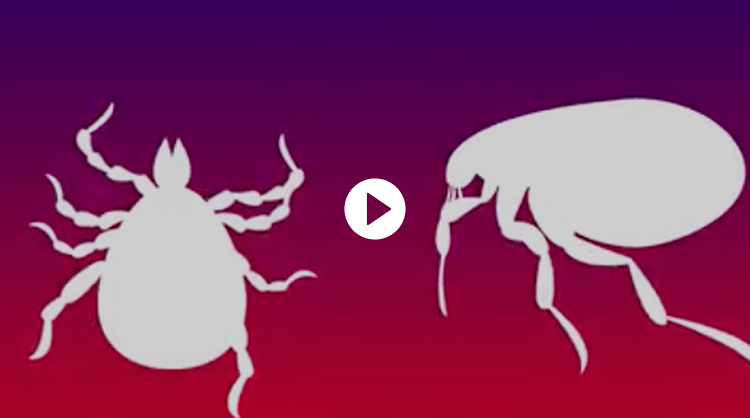
How can your pooch get fleas?
It’s no surprise that being a first-time pet owner can be challenging. And now you need to figure out how to deal with fleas…which feels like a completely foreign experience. The truth is, once you’ve dealt with one out-of-control flea infestation, you’ve dealt with them all! The only difference between first-time pet parents and long-time pet parents is that they’ve learned, how pets catch fleas, how to get rid of fleas on puppies and how to make small changes in your life to prevent these dreaded blood-sucking parasites from coming back.
Once you have a better understanding of your puppy’s behaviour and their needs, you will also be able to research the best flea treatments for puppies. If possible, consult a local vet to discuss the options that will work for your dog’s breed and age. Bravecto®, for instance, can be used as a flea treatment for puppies from 8 weeks old. This is extremely helpful for first-time pet parents. To continue, here are the different ways in which your puppy can catch fleas, inside and outside.
Fleas can spread through other animals
If you have another animal at home, be it a cat or a dog, you are bound to experience significantly more flea troubles as one may catch fleas and spread it to the other. It spreads like a wildfire. However, if you do not have another pet, but you are trying to socialise your puppy with classes, your pooch might pick up fleas from other dogs at these classes.
Fleas can spread through human transportation
People tend to forget that fleas can be transported via your shoes, socks and clothing. If you visit friends or family and their animals are infested with fleas, you will pick them up and bring them home. Not to mention, if others visit you at your flea-free home, they can also carry fleas into your home without even knowing. Fleas adapt well in various environments and climates; therefore, it’s easy for these parasites to latch onto humans and infest your house at a later stage.
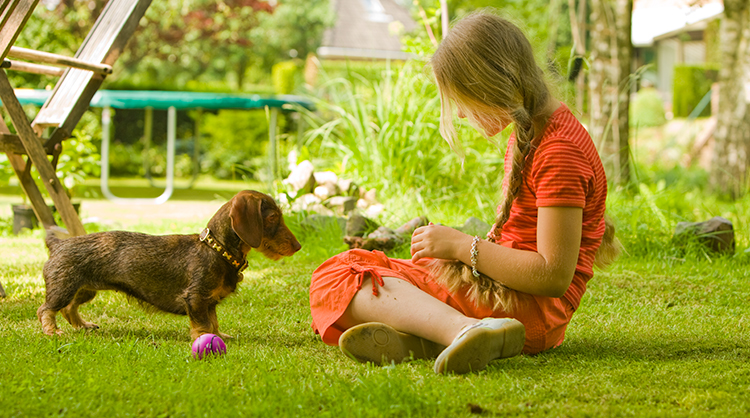
Fleas can spread from outdoor environments
It’s a no-brainer that you (and your pooch) can catch fleas from the outdoors. Even if your backyard is neat, and you’ve eliminated all the debris from areas, cleaned your flower beds and made sure that the sun removes any warm, moist sections of dirt for fleas to breed in, your pup can catch fleas on your daily walks. Be it at the park, around the neighbourhood or at puppy class; your furball is constantly exposed to fleas if you don’t protect them against them.
Beyond these sources, you need to factor in the season. In South Africa, fleas are most active over the summer months; however, they can start emerging from September already. The winter months, fleas will lie dormant whereas ticks prefer colder climates. Having said this, during winter we keep our homes nice and warm which is still ideal for fleas to breed and multiply; hence, the need for an all-encompassing product that can fight these parasites regardless of the season. Before you gear up for summer, it’s crucial to consider flea and tick protection for puppies. A product like Bravecto® will give you peace of mind knowing that your adorable pup is protected – a single dose will protect your pup or dog for the whole winter season.
It’s important to note that you should not ignore the winter months simply because you feel your pup was “covered” in summer. Once these parasites make their way into your home, the cold will not affect them, and they will continue to breed in warm spaces. They will also affect you, as a human. So, look after your own health while you’re at it.
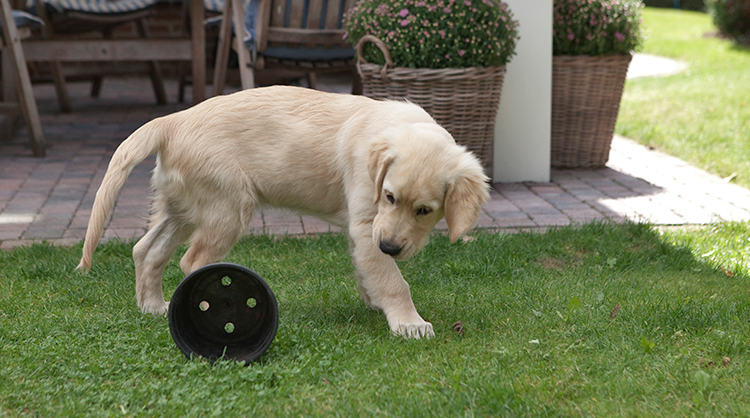
Simple tips to take control of fleas
If you are worried about your pup catching fleas, follow the below simple tips on how to prevent any infestation.
Treat the environment your pup is in
It can be difficult to know how to get rid of fleas on puppies when you faced with a major flea infestation, and it can seem like a mammoth task ahead to overcome this battle. According to this article, “only 5% of fleas in home live on pets, the other 95% – in the form of eggs, larvae and pupae – live in the house and garden.” And if you think that is crazy, try comprehending how one single female flea can lay up to 45 eggs a day. Now, whether these fleas are dormant or showing face in your house and backyard, it can be an absolute itchy mess. Make sure that you bathe your pooch, wash their bedding and bed, vacuum your floors and furniture and clean up your yard. These are the steps you are going to need to take to get rid of fleas on puppies.
Treat your puppy’s mother
It might be too late now, but in future cases, make sure your puppy’s mum is tick and flea-free. As per our frequently asked questions (FAQs), Bravecto® Chew and Bravecto® Spot-On For Dogs, are amongst the best flea treatments for puppies. They are safe and may be used in pregnant and lactating mums.
Treat your puppy weeks after their birth
Bravecto® offers flea treatment for puppies from 8 weeks old. It’s extremely dangerous to leave your pup with a flea infestation during its early days because it can lead to more serious illnesses and diseases. For instance, fleas can lower their blood flow and affect your pups’ energy levels and exposes them to the risk of tapeworm.
Treat your puppy regularly
It’s always better to prevent fleas than stressing about how to get rid of fleas on puppies. Make sure you give your pup a dose of Bravecto® every three months and keep monitoring your pooch’s body for fleas. If you notice flea symptoms but are unsure, consult with a local vet on the correct procedure to take for your pup.
Groom your puppy to prevent fleas
Always take the time to comb your pup’s coat to ensure there are no ticks or fleas sitting on your pup’s skin. Daily grooming (and cuddle) sessions will allow you to take a closer look at your pooch and monitor their coat and general condition. In addition to spotting fleas, grooming can benefit your doggo in a variety of different ways. For example, it keeps your pet looking neat, helps to create a bond with your dog and it removes any dead hair or skin on their coat.
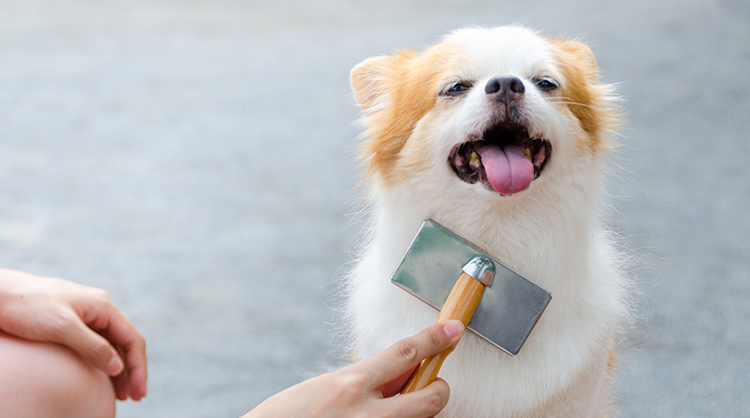
Read through our frequently asked questions (FAQs)about Bravecto®
(If you want to speak to MSD Animal Health about our products, we’re always here to help. Please visit our website for more information on how to get in touch.)
How is Bravecto® different from other chewable or topical tick and flea treatments?
Unlike other monthly treatments, Bravecto® Chew and Bravecto® Spot-On For Dogs can offer your pooch 3 to 6-months of protection against ticks, fleas and ear mites. Our Chew is a tablet, whereas our Spot-On treatment is a solution that is applied to the back of your dog’s neck. It lasts at least three times longer than traditional products, making it cost-effective. With just one dose, you will be able to break the flea lifecycle and kill 100% of fleas in eight hours of use.
How safe is Bravecto® Chew for dogs?
Our trusted and the vet recommended products for dogs are safe and ideal for puppies weighing as little as 2kg. Depending on the long-term coverage you want to offer your dog, you can choose between Bravecto® Spot-On For Dogs, which will protect for 4 months against ticks and 6 months against fleas, or the Bravecto® Chew which is South Africa’s leading tick, flea and mite protection product. It is a tasty Chew and offers 12-weeks of tick, flea and mite protection for your dog.
How does Bravecto®kill fleas and ticks?
Bravecto®gets absorbed into and circulates in the bloodstream, this is exactly where it is needed as this is what ticks and fleas feed on. Once ticks and fleas feed on your furry friend’s blood, they will be ingesting the active ingredient, fluralaner, which will kill parasites within hours. Our unique product offers long-term coverage, meaning it lasts at least three times longer than any other traditional monthly spot-on treatments. Bravecto® Chew is a tasty chew that protects against ticks, fleas and mites for 12 weeks and Bravecto® Spot-On For Dogs is a spot-on treatment that protects against ticks for 4 months and 6 months against fleas.
Get your dose of Bravecto®
today!
If we’ve convinced you to try our product and experience the extraordinary Bravecto® difference for you and your dog, speak to your local vet today! Bravecto® is available from your veterinarian, veterinary clinic or a selection of online vet stores.
Click here to find a vet today and give your furball the protection he deserves.
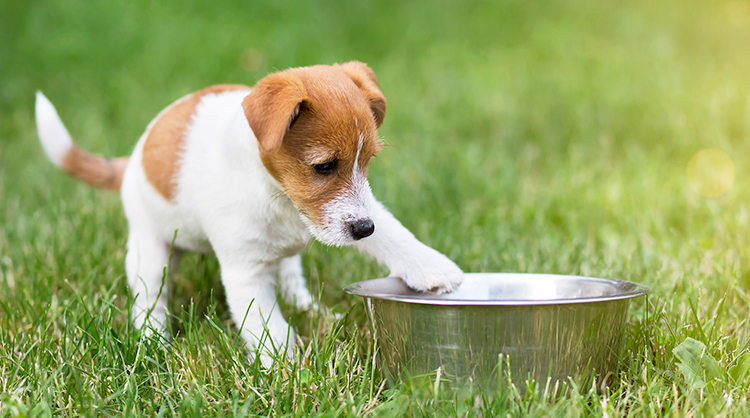
Sources
https://www.yourfamily.co.za/family-life/my-puppy-has-fleas-what-do-i-do
https://www.petmd.com/dog/parasites/how-dangerous-are-fleas
https://www.dummies.com/pets/dogs/safe-options-for-treating-your-puppys-fleas/
https://www.purina.co.uk/dogs/health-and-nutrition/grooming-and-daily-care/spotting-and-treating-fleas
https://www.petmd.com/dog/parasites/evr_dg_how_did_my_dog_get_fleas_and-or_ticks
https://www.prestigepetresort.com/blog/importance-of-grooming-for-flea-and-tick-prevention.html
https://www.thesprucepets.com/puppy-parasites-2805021
https://www.hillspet.co.za/dog-care/new-pet-parent/bringing-home-a-puppy
Subscribe to our Newsletter
Get to know your furry friend better! Sign up for all things dog- or cat-related.
The Hairy Facts about the dreaded hairball
12 April 2021
Help! My dog’s barking mad! Volume 2
12 April 2021
Your Itchy, Scratchy Cat – All About Cat Skin Problems
12 April 2021
The Dog’s Diet: A Bone of contention?
01 April 2021
Mango Fly Worms: How to Spot and Eliminate them
Posted on November 28,2019
Managing Mange And Mites In Your Dog
Posted on June 11,2018
Why Do Cats Purr and How? Learn What Your Cat Is Saying
Posted on October 14,2020
How to Get Rid of Ear Mites in Dogs
Posted on November 06,2019









